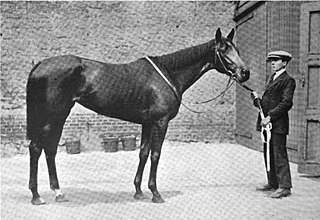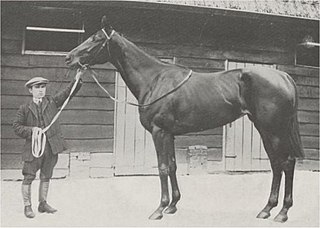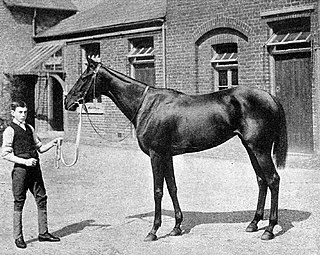Toboggan was a British Thoroughbred racehorse and broodmare. She showed very promising form as a juvenile in 1928 when she won three of her four races including the Dewhurst Stakes. In the following year she finished third in the 1000 Guineas and went on to win the Epsom Oaks, Coronation Stakes and Jockey Club Stakes. She had some success as a broodmare producing the top-class winner Bobsleigh and Hydroplane, the dam of Citation.

Princess Dorrie was a British Thoroughbred racehorse and broodmare. As a two-year-old in 1913 she failed to win a race but was very consistent, finishing placed in seven of her eight starts. In the following year she was probably the best three-year-old filly in England, winning both the 1000 Guineas and the Epsom Oaks. She was retired at the end of the 1914 season and had modest success as a broodmare.

Rosedrop (1907–1930) was a British Thoroughbred racehorse and broodmare. She won one minor race as a two-year-old in 1909 before emerging as a top-class performer in the following year. She won the Epsom Oaks, Atalanta Stakes and Great Yorkshire Stakes as well as finishing third in the 1000 Guineas and the Park Hill Stakes. After her retirement from racing she became a broodmare in England, and later in the United States. By far the best of her offspring was Gainsborough who won the 13th U.K. Triple Crown Champion and became a very successful breeding stallion.

Perola was a British Thoroughbred racehorse and broodmare. She was one of the best juvenile fillies in England in 1908 when she won four of her seven races, including the Woodcote Stakes, as well as being placed behind Bayardo in both the New Stakes and the Dewhurst Stakes. In the following year she finished third in the 1000 Guineas and then recorded her biggest win in the Oaks Stakes. In early 1910 she was sold and exported to France to become a broodmare.

Tranquil was a British Thoroughbred racehorse and broodmare. She showed considerable promise as a two-year-old when she won one race and finished second in the Gimcrack Stakes. In the following season she was one of the best horses in Britain, scoring classic victories in the 1000 Guineas and St Leger Stakes as well as winning four other races including the Jockey Club Cup and Newmarket Oaks. he won once in 1924 before her racing career was ended by injury. She made no impact as a broodmare.

Norman was an American-bred, British-trained Thoroughbred racehorse and sire. He was exported from the United States as a yearling and showed some promise as a juvenile in 1907 when he won twice from nine starts. In the following spring he recorded a 25/1 upset victory in the 2000 Guineas. He was unplaced when favourite for the Epsom Derby and finished last in the St Leger but ended his second season with a victory in the Newmarket St Leger. He raced for another two seasons but never recaptured his classic winning form. He made no impact as a breeding stallion.
Tide-way was a British Thoroughbred racehorse and broodmare. She was rated one of the best British two-year-old fillies of 1935 when she won twice from four starts. She won the 1000 Guineas on her debut as a three-year-old but finished unplaced in the Epsom Oaks and never ran again. As a broodmare she produced the Eclipse Stakes winner Gulf Stream.
Campanula was a British Thoroughbred racehorse and broodmare. In 1933 she won two of her five races including the Windsor Castle Stakes and the Moulton Stakes and was rated the best juvenile filly in England. In the following spring she won the Column Produce Stakes and then recorded her biggest win in the 1000 Guineas. In her two subsequent races she finished fourth in the Epsom Oaks and second in the Champion Stakes. As a broodmare she exerted an enduring influence as a broodmare through her daughter Calluna.
Cinna was a British Thoroughbred racehorse and broodmare. She showed great promise as a juvenile in 1919 when she won a very competitive maiden race on her debut before finishing second in the New Stakes and the Bretby Stakes. As a three-year-old she won the 1000 Guineas and the Coronation Stakes and was narrowly beaten when favourite for the Epsom Oaks. She was retired from racing at the end of the year and went on to be a very successful broodmare. Three of her sons became leading sires in Australasia whilst several of her daughters became influential broodmares including the female-line ancestors of Sunday Silence and Indian Ridge.

Atmah was a British Thoroughbred racehorse and broodmare. She failed to win as a two-year-old but showed considerable promise on her final start when she ran third in the Dewhurst Stakes. In the following year she contested four of the five British Classic Races, recording her biggest success when taking the 1000 Guineas. She made no impact as a broodmare.
Electra was a British Thoroughbred racehorse and broodmare. A a two-year-old she showed considerable promise as she won four time from eight starts and finished second on three occasions. In the following year she won the 1000 Guineas and the Park Hill Stakes as well as finishing second in the Newmarket Stakes, Coronation Stakes and Free Handicap. She appeared to be most unlucky when running unplaced in the Epsom Oaks. She failed to win as a four-year-old and was retired from racing but later became a very successful broodmare.

Flair was a British Thoroughbred racehorse and broodmare. After finishing fourth on her debut in July 1905 she was undefeated in her four subsequent races. She was the dominant two-year-old of either sex in England in the autumn of 1905, beating male opposition to take the Imperial Produce Stakes, Middle Park Plate and Free Handicap. In the following spring, she was a very easy winner of the 1000 Guineas and was strongly fancied for the Epsom Derby before her racing career was ended by injury. Her record as a broodmare was disappointing.

Aida was a British Thoroughbred racehorse and broodmare. As a juvenile she finished second on her debut and then defeated the future Epsom Derby winner Volodyovski in the Imperial Produce Stakes. She won the 1000 Guineas on her first appearance of 1901 and then finished a close third in a very strong edition of the Newmarket Stakes. She finished unplaced in the Eclipse Stakes and the St Leger and was retired from racing at the end of the year. As a broodmare she had an enduring influence on the breed through her daughter Herself.

Sibola (1896–1921) was an American-bred, British-trained Thoroughbred racehorse and broodmare. She was sent to England as a yearling and showed some promise as a two-year-old in 1898 although she failed to win a race. In the following year, she was the most successful filly of her age in England, taking the Wood Ditton Stakes, 1000 Guineas, Derby Biennial Foal Stakes and Scarborough Stakes as well as finishing a close and unlucky second in the Epsom Oaks. She remained in training until the age of five but never recovered her best form. As a broodmare she had an enduring influence on the breed as the female-line ancestor of Nearco.

Chelandry (1894–1917) was a British Thoroughbred racehorse and broodmare. She was the top-rated juvenile filly in England in 1896 when she won the Woodcote Stakes, Great Surrey Breeders' Foal Plate, National Breeders' Produce Stakes and Imperial Produce Stakes. In the following year she won the 1000 Guineas and finished second in both the Epsom Oaks and the St Leger. She remained in training as a four-year-old but failed to win again and was retired at the end of the year. After her retirement from racing, she became an exceptionally successful and influential broodmare.
Thais (1893–1898) was a British Thoroughbred racehorse and broodmare. She showed very promising form as a juvenile in 1895 when she was placed in the New Stakes and the July Stakes before winning the Crabbet Plate at Gatwick. In the following year she won the 1000 Guineas and finished second in both the Epsom Oaks and the Coronation Stakes before being retired at the end of the season. She had no chance to prove her worth as a broodmare, dying at the age of five without producing a foal.
Canterbury Pilgrim (1893–1917) was a British Thoroughbred racehorse and broodmare. She showed some ability as a juvenile but failed to win a race. She won the Oaks Stakes on her first run as a three-year-old and went on to win the Liverpool Summer Cup, Park Hill Stakes and Jockey Club Cup before being retired at the end of the year. As a broodmare the best of her offspring was Swynford, a top-class racehorse who was even better as a breeding stallion. She also produced the influential sire Chaucer and several good broodmares. She has been described as "one of the most influential horses, stallion or mare, of the Twentieth Century".

Musa was a British Thoroughbred racehorse and broodmare. As a two-year-old in 1898, she failed to win but showed great promise by being placed in several major races including the New Stakes. In the following spring, she finished third in the 1000 Guineas before winning the Epsom Oaks. She ran unplaced in two subsequent starts and was retired from racing at the end of the year. She had considerable success as a broodmare.
Mimi was a dual classic-winning British Thoroughbred racehorse and broodmare. As a two-year-old in 1890 she showed very promising form to win her first four starts but was well beaten when stepped up in class to contest the Middle Park Plate and the Dewhurst Plate. She established herself as the best filly of her generation in May 1891 with three wins in 26 days, taking the 1000 Guineas over one mile, the Newmarket Stakes over ten furlongs and the Oaks Stakes over one and a half miles. She was subsequently beaten in the Prince of Wales Stakes at Leicester and was no match for Common in the St Leger. She was retired from racing at the end of the year and went on to have some success as a dam of winners.
Throstle (1891–1910) was a British Thoroughbred racehorse and broodmare. Born partially blind and considered a likely candidate for euthanasia as a foal she nevertheless proved herself one of the two best fillies of her generation in Britain. She showed considerable promise despite failing to win in three starts as a juvenile in 1893 and began her second season by running sixth to Amiable in the 1000 Guineas. In the summer of her second season she made rapid progress, winning the Coronation Stakes and Nassau Stakes as well as finishing fourth against very strong male opposition in the Eclipse Stakes. Poor form in training led to her starting at odds of 50/1 for the St Leger but she created a huge upset by defeating the Epsom Derby winner Ladas. She failed to win again and was retired from racing in 1895. She had little success as a dam of winners.











